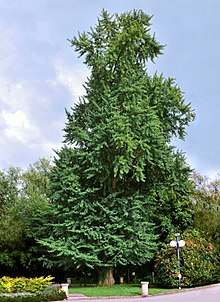பாசில் மரம்
| பாசில் மரம் புதைப்படிவ காலம்:Early இயோசீன் (முன் இயோசீன்) – Present[1] | |
|---|---|

| |
Invalid status (NatureServe)[3]
| |
| உயிரியல் வகைப்பாடு | |
| Unrecognized taxon (fix): | சிங்கோ |
| இனம்: | Template:Taxonomy/சிங்கோச. பிலோபா
|
| இருசொற் பெயரீடு | |
| ச பிலோபா L. | |
| வேறு பெயர்கள் [4] | |
| |
சிங்கோ பிலோபா (Ginkgo biloba)[5], பொதுவாக சிங்கோ அல்லது வாழும் தொல்லுயிர் எச்ச மரம் எனவும் அறியப்படும் இது கிழக்காசியாவை பூர்வீகமாகக் கொண்ட ஒரு வித்துமூடியிலி தாவர இனத்தைச் சேர்ந்தது.[6][7] இது 290 மில்லியன் ஆண்டுகளுக்கு முன்பு முதன்முதலில் தோன்றிய சிங்கோலஸ் வரிசையில் கடைசி உயிருள்ள இனமாகும். மேலும் சிங்கோ இனத்தைச் சேர்ந்த உயிருள்ள இனங்களுடன் மிகவும் ஒத்திருக்கும் புதைபடிவங்கள் சுமார் 170 மில்லியன் ஆண்டுகளுக்கு முன்பு மத்திய ஜுராசிக் சகாப்தம் வரை நீண்டுள்ளன.[2] இந்த மரம் மனித வரலாற்றின் ஆரம்பத்தில் பயிரிடப்பட்டது. மேலும் இது ஒரு வாழும் தொல்லுயிர் எச்சமாக பரவலாகக் கருதப்படுகிறது.[8]

மரத்தின் இலை சாறு பொதுவாக ஒரு உணவுடன் உண்ணக்கூடியதாகப் பயன்படுத்தப்படுகிறது. ஆனால் இது மனித ஆரோக்கியத்திற்கு உதவுகிறது அல்லது எந்தவொரு நோய்க்கும் எதிராக பயனுள்ளதாக இருக்கும் என்பதற்கு போதுமான மருத்துவ சான்றுகள் இல்லை.[9][10]
மரத்தின் அமைவு
[தொகு]இது உயிருடன் இருக்கும் ஒரு வாழும் தொல்லுயிர் எச்ச மரமாகும். இது கார்பனிபெரஸ் காலம் முதல் அதாவது 25 கோடி ஆண்டுகளுக்கு முன்னிருந்து புதை ப்டிமங்களாக அகப்படுகின்றன. சிங்கோ சாதியின் இந்த இனம் ஒன்றே நிலைத்திருக்கிறது. 10-20 கோடி ஆண்டுகளாக எந்தவித மாற்றமும் அடையாமல் அப்படியே இருந்து வருகிறது. இது மனிதன் தோன்றுவதற்கு பல கோடி ஆண்டுகளுக்கு முன்பும், அதகன்ற இலைகளுக்குள்ள மரஞ்செடிகள் தோன்றுவதற்கு முன்பும் தோன்றி வளர்ந்த மரமாகும். மேலும் இது உலகின் மிகவும் பழமையான பூக்கும் தாவரம் ஆகும்.
மரத்தின் சிறப்பு
[தொகு]இம்மரம் 130 அடி உயரம் வரை வளரக்கூடியது.[11] இம்மரத்தின் பட்டை சிவப்பாக இருக்கும். இவைகளில் ஆண்மரம், பெண்மரம் எனத் தனித்தனியாக இருக்கிறது. இதனுடைய இலை மிக அழகாக இருக்கும். விசிறி போன்ற வடிவில் இருக்கும். இலையின் நரம்புகள் அடியிலிருந்து பிரிந்து விளிம்பைப் போல் சேரும். இதனால் இதைக் “கன்னிக்கூந்தல் மரம்” என்றும் அழைப்பார்கள்.[12][13] இவ்விலைகள் விழும் சமயத்தில் தங்க நிறமாக மாறும்.[14][15][16][17] இது உறையில்லாத விதையுள்ள மரம். இதில் கனி என்பது விதையே ஆகும். இதன் விதையை வறுத்து சாப்பிடலாம்.
காணப்படும் பகுதிகள்
[தொகு]இம்மரம் சீனாவில் காணப்படுகிறது.[18][19] சிங்கோ என்பது சீனப்பெயராகும். சீனாவில் இம்மரங்களை தெருக்களின் இருபுறமும் அழகிற்காக நடுகிறார்கள்.[20]
இதனையும் காண்க
[தொகு]மேற்கோள்கள்
[தொகு]- ↑ Mustoe, G.E. (2002). "Eocene Ginkgo leaf fossils from the Pacific Northwest". Canadian Journal of Botany 80 (10): 1078–1087. doi:10.1139/b02-097.
- ↑ 2.0 2.1 Sun, W. (1998). "Ginkgo biloba". IUCN Red List of Threatened Species 1998: e.T32353A9700472. doi:10.2305/IUCN.UK.1998.RLTS.T32353A9700472.en. https://www.iucnredlist.org/species/32353/9700472. பார்த்த நாள்: 19 November 2021.
- ↑ "NatureServe Explorer 2.0". explorer.natureserve.org. Retrieved 31 March 2022.
- ↑ "Ginkgo biloba", தாவரக் குடும்பங்களின் தேர்ந்த உலக சரிபார்ப்புப் பட்டி, அரச கழக தாவரவியல் பூங்கா, கியூ, retrieved 1 July 2024
- ↑ சிறிதும் - பெரியதும். அறிவியல் வெளியீடு.
- ↑ "Ginkgo: Definition & Meaning". www.merriam-webster.com (in ஆங்கிலம்). Retrieved 2 July 2021.
- ↑ "ginkgo". dictionary.cambridge.org. Retrieved 2 July 2021.
- ↑ Zhou, Zhi-Yan (March 2009). "An overview of fossil Ginkgoales" (in en). Palaeoworld 18 (1): 1–22. doi:10.1016/j.palwor.2009.01.001. https://linkinghub.elsevier.com/retrieve/pii/S1871174X0900002X.
- ↑ "Ginkgo". National Center for Complementary and Integrative Health, US National Institutes of Health. 1 August 2020. Retrieved 19 February 2021.
- ↑ "Ginkgo biloba". Drugs.com. 19 December 2023. Retrieved 13 April 2024.
- ↑ Ansari, Abid A.; Gill, Sarvajeet Singh; Abbas, Zahid Khorshid; Naeem, M. (2016-12-23). Plant Biodiversity: Monitoring, Assessment and Conservation (in ஆங்கிலம்). CABI. ISBN 978-1-78064-694-7.
- ↑ "Ginkgo biloba". Natural Resources Conservation Service PLANTS Database. USDA.
- ↑ "More on Morphology of the Ginkgoales". www.ucmp.berkeley.edu. Archived from the original on 17 October 2000. Retrieved 12 August 2006.
- ↑ Meyer, Jeffrey G. (2004). The Tree Book: A Practical Guide to Selecting and Maintaining the Best Trees for Your Yard and Garden (in ஆங்கிலம்). Simon and Schuster. p. 113. ISBN 978-0-7432-4974-4.
- ↑ "Ginkgo Tree". www.bio.brandeis.edu. Retrieved 18 July 2016.
- ↑ "Ginkgo Tree". prezi.com. Retrieved 18 July 2016.
- ↑ "PlantsMap". Plants Map (in ஆங்கிலம்). Retrieved 2022-06-24.
- ↑ Roger Cohn (1 May 2013). "The life story of the oldest tree on Earth (interview of Peter Crane)". Yale Environment 360, Yale School of the Environment. Retrieved 3 September 2021.
- ↑ Fu, Liguo; Li, Nan; Mill, Robert R. (1999). "Ginkgo biloba". In Wu, Z. Y.; Raven, P.H.; Hong, D.Y. (eds.). Flora of China. Vol. 4. Beijing: Science Press; St. Louis: Missouri Botanical Garden Press. p. 8.
- ↑ Wang, Lukun; Liu, Jiamin; Liu, Jing; Wei, Haiyan; Fang, Yaqin; Wang, Daju; Chen, Ruidun; Gu, Wei (2023-05-01). "Revealing the long-term trend of the global-scale Ginkgo biloba distribution and the impact of future climate change based on the ensemble modeling" (in en). Biodiversity and Conservation 32 (6): 2077–2100. doi:10.1007/s10531-023-02593-z. பன்னாட்டுத் தர தொடர் எண்:1572-9710. Bibcode: 2023BiCon..32.2077W.
வெளி இணைப்புகள்
[தொகு]
- Ginkgoopsida, Ginkgoales, Ginkgoaceae, Ginkgo biloba (ginkgo) description, The Gymnosperm Database
- Ginkgo biloba information, Plants for a Future Plant Database
- Ginkgo biloba, PlantUse English


